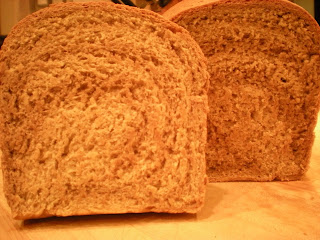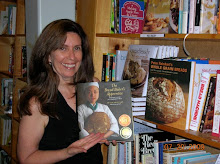I said to myself, "Oh, well, what the heck? I'm committed to this project; let's see what happens. I dutifully mixed the dough - yes - with the ice water, thinking all the while, un, hmmm - sure Pete - I was somewhat surprised at the resulting dough, but did not think too much about it. I was more concerned trying to find room in my fridge for the bowl with the rising dough inside.
Didn't think a thing about it the rest of the night or the next day at work. When I got home from a particularly long day at 9:00 (!), I remembered I had that bread to deal with. I took it out to de-chill, and to my surprise, it had risen quite well.
Now, while I live in San Diego, let me dispel a myth right now - it does rain and it does get cold - okay maybe only for the blink of an eye, but it does, and it was that night. I thought it was way too cold for this to ever de-chill, but I set it on the counter and busied myself with a project upstairs in my home office. At about 11:00, I remembered the bread. When I went downstairs to shape it, I thought, hmmm, this may not be so bad after all. As I began to shape it, I began to see the potential for this bread. What a fantastic dough! It had a wonderful springiness to it. I decided to be a heretic, though, and formed it into a hearth loaf, rather than baguettes. I simply wasn't in the mood for baguettes; with all this winter chill, I wanted a big, round, earthy hearth loaf. As I shaped it, though, I noticed it gave me difficulty in securing the bottom of the loaf. I rounded it the best I could, placed it on a parchment-lined sheet pan onto which I had sprinkled a good amount of finely ground cornmeal. I covered it with an impeccably clean kitchen towel, preheated the oven to 500 degrees, set the timer and went back to my project upstairs.
For anyone interested, my project was printing out and binding into book form poetry and commentaries on their writing experiences that my 7th grade students had written. They did such a fantastic job on this, that I decided to gift them with their own copy of the book.
When I checked on the bread later, it was as I had anticipated. It did not rise high and round, but rather like a large pancake with a small mound on top.

Oh, just get it in the oven, already, I thought. I had set a pan on the bottom shelf, and I went through the motions of steaming the oven for hearth baking - pouring a cup of hot water into the pan just as the bread went in; dousing the oven walls with water every 30 seconds thereafter for 90 seconds, set the timer, and went back upstairs. I know. How cheeky of me to leave the bread unattended! But when I came back about 20 minutes later, to my astonishment and delight, the bread had risen like the phoenix.
My "pancake" had risen to a tall and majestically round loaf, brown and gorgeous. I turned the oven down to 475 and let it go another 10 - 15 minutes. When I returned again, it looked done, but when I checked the internal temperature, it wasn't even at 100 degrees yet, and the thermometer came out with a big glob of wet dough on it. Uh, oh, I thought. I was afraid of this. Since the original recipe was for baguettes, and the dough was rather wet, I had anticipated that this might be problematic. I turned the oven way down to 300 degrees and checked every 10 minutes until the temp registered 207 degrees. I don't even know how much longer that took, but it was at least another 30 minutes.
By now it was 2:00 a.m., and I had to go to work in just a few short hours, so I photographed the loaf, and let it sit on the rack overnight. For the first time since this challenge began, I did not slice into the loaf and taste it fresh and hot from the oven.
In the morning, however, I sliced off a piece and was stunned to see the most perfect crumb I have seen yet coming from a loaf of my bread in the 35+ years that I have been baking bread. Of course, I spread a little butter on it, and - well - it was amazing! It had a completely different taste and texture from other breads.
Peter, my hat's off to you, and I will never doubt your methods again. You are the master. Of course, the real question is why would I doubt anyone who dreamed up the phrase, "Slow rise as metaphor?" It is magical; it is mystical; it is a metaphor. Oh, and it is mighty tasty too. The flavors must have married well and had some mystical fermentation magic going on in my fridge overnight, but we won't go there.

































